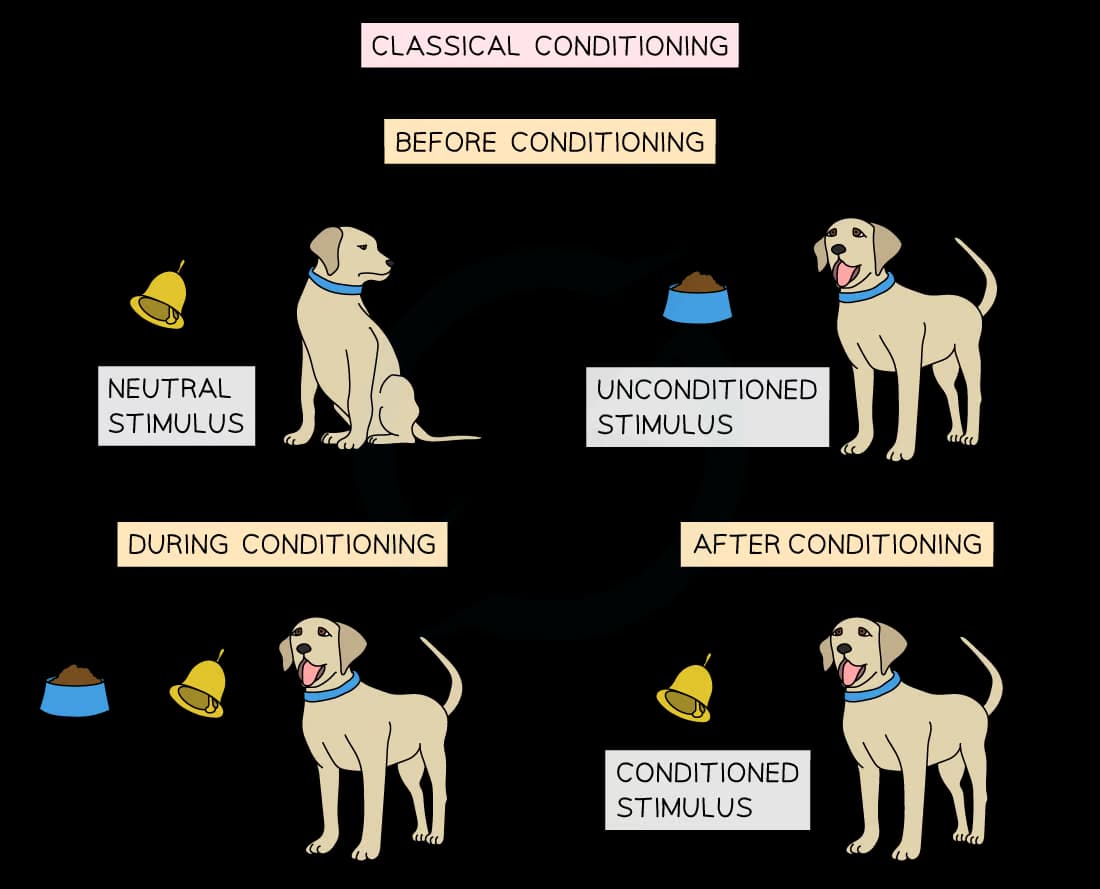Syllabus Edition
First teaching 2015
Last exams 2025
Classical Conditioning & Pavlov's Research (AQA AS Psychology): Revision Note
Exam code: 7181
Assumptions of the behaviourist approach
The behaviourist approach assumes that:
everyone is born as a 'blank slate' which life writes upon (Watson, 1930)
all behaviour is learned from the environment e.g. upbringing, neighbourhood, peers, education
behaviour can be understood via
a stimulus-response approach (classical conditioning)
the mechanisms of reward and reinforcement(operant conditioning)
Behaviours which can be directly observed only can be measured
Imitation of specific aggressive behaviours can be observed and measured
Memory cannot be measured as it cannot be directly observed
Lab-based, scientific methods are the only way that behaviour can be studied
Animal research may be used as a basis for understanding human behaviour
Repeated behaviours become internalised and automatic e.g.
hearing the bell ring for the end of the lesson triggers packing away and moving to the next lesson without any real thought involved
Classical conditioning and operant conditioning underpin the principles of behaviourism
Classical conditioning
Classical Conditioning (CC) is learning via association and is one of the core assumptions of the behaviourist approach
CC occurs when a neutral stimulus is substituted for the original unconditioned stimulus to produce a conditioned response
An unconditioned stimulus produces a natural, unforced response i.e. no animal or human has to learn how to feel hunger
The mechanisms of CC are as follows:
The unconditioned stimulus (UCS) is the starting point
The UCS is a stimulus that produces an unconditioned response (UCR):
Food is an UCS as it is a natural, physiological reflexThe UCR to food being presented is to salivate/feel hungry
The UCS is paired with a neutral stimulus (NS):
One which, ordinarily and on its own, does not produce a strong response (neither positive nor negative) e.g. a tone being sounded
When the UCS is paired with the NS the response continues to be the UCR, as a result of the UCS
After repeated pairings, the NS is presented on its own and elicits the UCR e.g. salivation
The NS has thus become the conditioned stimulus (CS) and the salivation has become the conditioned response (CR)
When the CS is presented it will result in the CR
The CR is generally not as strong as the UCR
After some time the NS must be paired with the UCS again otherwise extinction will occur
Pavlov's research
The mechanisms of classical conditioning were discovered accidentally by Pavlov (1897), a physiologist who was measuring the volume of specific enzymes in dog saliva
Pavlov had been working with dogs in his lab:
The dogs were attached to an apparatus which held them in place and collected their saliva
Pavlov noticed that the dogs began to salivate before they saw or smelt their food
They began to salivate when they heard the footsteps of the lab assistants approaching (the dogs had learned that these footsteps = food!)
Pavlov was astounded by this discovery as he believed the dogs should only salivate when presented with the UCS - food - rather than an NS (footsteps)
To test what he had just discovered he set up the following procedure:
The dog is given food as usual (UCS)
The dog salivates when it sees and smells the food (UCR)
A bell is sounded (NS) every time the dog is given food (UCS)
A bell is sounded every time the food is presented (the pairing of NS and UCS)
After repeated pairings, the dog salivates when it hears the bell
The bell has become the CS
The dog salivating to the sound of the bell has become the CR
The dog continues to salivate to the bell however when Pavlov stopped pairing the bell and the food he found that the CR decreased and gradually disappeared (known as 'extinction')

Examiner Tips and Tricks
Ensure you understand the processes involved in classical conditioning, particularly the difference between unconditioned and conditioned stimulus/response. If you confuse these terms in your answer you could lose marks.
Evaluation of classical conditioning & Pavlov's research
Strengths
The use of scientific methods (e.g. lab experiments)
Reliability is based on the use of a testable hypothesis
Hypothesis testing takes place in controlled conditions using standardised, replicable procedures
The above measures produce results which should show consistency over time
Thus, research into behaviourism has good reliability
Behaviourism takes a nomothetic approach which is a strength as it seeks to establish general laws of behaviour which can be applied universally to all people
Limitations
Whilst classical conditioning may explain some forms of behaviour, it cannot explain all behaviour, e.g.
behaviour which is spontaneous or original e.g. dyeing your hair bright blue
behaviour which resists conditioning e.g. someone who has been brought up in a strict religious environment who goes on to reject that religion
This means that classical conditioning has limited external validity
Behaviourism is highly deterministic (environmental determinism)
The assumption is that people are controlled by environmental forces and have little autonomy over their destiny
This assumption negates the role of free will in behaviour which reduces the usefulness of the approach, seeing people in almost mechanical terms

Unlock more, it's free!
Did this page help you?